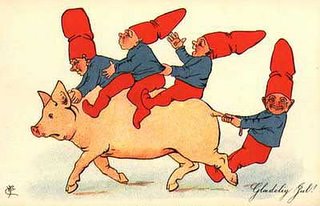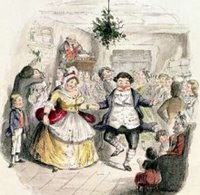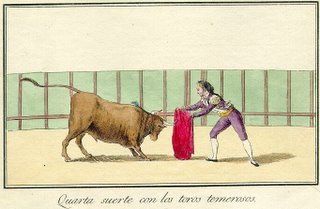



 Tauromaquia o arte de torear á caballo y á pie by José Delgado y Gálvez is online at the University of Mannheim Mateo website. (something like: 'Bullfighting using a horse and one's feet')
Tauromaquia o arte de torear á caballo y á pie by José Delgado y Gálvez is online at the University of Mannheim Mateo website. (something like: 'Bullfighting using a horse and one's feet')
It was originally published at the end of the 18th century and after Professor Gálvez's death a new edition was released in 1804 which included 30 lithographic plates that were made by a fan of bullfighting. I've selected some of the less gory examples.
Saturday, December 24, 2005
The Matador Manual
Friday, December 23, 2005
Charmsizdat
Thursday, December 22, 2005
The Family Nest-Egg

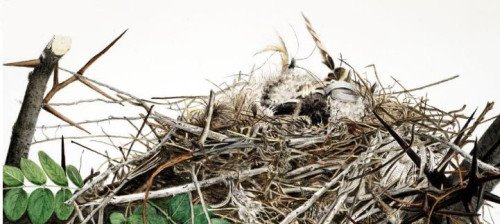


In 1876 Genevieve Jones returned to her small town in Ohio after being inspired by the great Audubon bird illustrations she had seen at the Philadelphia Exhibition. She shared a love of natural history with her father and brother and as part of her home schooling, her mother had taught Genevieve to paint with watercolours. It was her hope to produce a book that would complement the work of Audubon.
Together with a childhood friend, Eliza Jane Schulze, Genevieve prepared double-sided lithographic stones with the intention of documenting all the nests and eggs from birds in the Ohio region, funded by her father. Her brother collected the samples for illustration and wrote up field notes. The first 65 pound lithographic stone was sent 50 miles away for printing into a subscription series in 1879. It was received with overwhelming enthusiasm and was fully subscribed.
But Genevieve died soon after from typhoid fever. She had only finished 15 lithographs and her mother then hired colourists to assist in producing the illustrations for the 100 subscribers as a tribute to her daughter's memory. It took 7 years for the complete series to be released.
30 of the 130 plates from 'Illustrations of the Nest and Eggs of Birds of Ohio' have (so far) been posted online at the Smithsonian Institution. It's a great website with an interesting display and background information about the series and Jones family.
As a purveyor of digital images which are consumed in split seconds - as they are for me too - I try to occasionally remember that I owe a debt of gratitude to the armies of people who curate, maintain, digitise and upload all the rare (and not so rare) book images we are privileged to observe online. I thought this was a thoroughly well written and interesting piece. The magnitude of the work required in restoration is amazing. I tip my hat in their general direction.
Wednesday, December 21, 2005
Astron







Incunabulum Astron-14 at the Herzog August Bibliothek Wolfenbüttel (thumbnail page).
Try as I might, I couldn't readily track down anything about this astrology/astronomy manuscript. The author is unknown. Handwriting at the front mentions Guido Bonatus (13th century astrologer), Erasmus (theologian/philosopher died 1536) and Melanchthon (Protestant theologian died 1560) but it's just as likely this was written after the manuscript had been completed in latin set-type. So probably late 15th/early 16th century at a guess.
[These images have been adjusted to remove the HAB watermark together with some artifact from paint bleeding]
Tuesday, December 20, 2005
Figuratively Speaking


I was thumbing through the Bildindex der Kunst und Architektur des Bildarchivs Foto Marburg website (Themen: natur) when the above 2 Georg Donauer images caught my eye. They date from 1611 and were in a Stuttgart festival book if I'm not completely misunderstanding. Donauer's name comes up in relation to iconography, architecture and musical instrument engravings in searching but it's a disparate link spread.
The eccentric caricatures reminded me of the outstanding series below by Braccelli (1624). This book was largely ignored until it was 're-found' in the mid-20th century and a new edition published.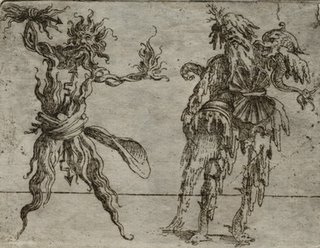
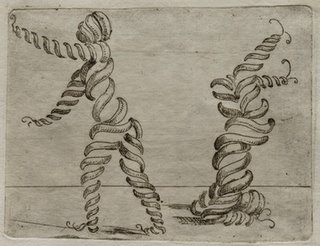
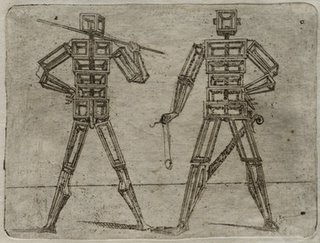
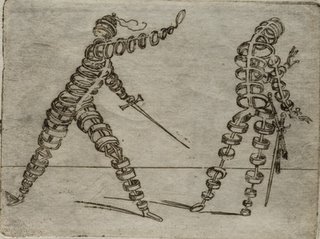
The 50 surreal illustrations from Bizzarie di Varie Figure by Giovanni Battista Braccelli are online among the Digital Materials from the Lessing J. Rosenwald Collection at the Library of Congress.
Definitely go see these 2 entries by misteraitch at Giornale Nuovo on Braccelli - if I haven't said it enough before, the Giornale is an outstanding website and I'm forever grateful for misteraitch's support and advice in relation to maintaining BibliOdyssey.
Timar on Miller



Lithographs by Timar for the 1947 limited edition of Henry Miller's Tropique du Cancer.
Brazenly filched from the 'Cosmodemonic Telegraph Company: A Henry Miller Blog', where there is much more information and links to further illustrations by Timar.
Monday, December 19, 2005
Robida's Future






French illustrator Albert Robida (1848-1926) was, in the eyes of some observers, something of a luddite or at least conservative when it came to making predictions about the future from his Victorian vantage point.
Although it might be stretching things to infer that his fiction series about the 20th century - Le Vingtième siècle (1883), La Guerre au XXe siècle (1887) & La Vie Électrique (1893) - was intended as any kind of overt warning, he seems to say that a world filled with gadgetry will be one where people will deceive themselves into believing that the 'new' is worthy despite obvious incongruences. He envisioned mass killing machines and an obliterated environment. Emancipation of women was portrayed not as advancement but as a lateral step. There are many new technologies to which people must adapt without any real progress in the quality of life.
This underlying pessimissm combined with artistic vision conferred a uniquely accurate (on some levels) presaging of things to come. Robida's téléphonoscope was the first inkling of the television that followed 30 years later. It was also a video conference phone allowing people to see and speak to anyone around the world. Telephone-like devices are of course ubiquitous, armies use robotic missiles and the atmosphere is polluted in Robida's future. Nevertheless the illustrations often retain a sense of humour and they provided another outlet for Robida's satirical observations, which proved equally as popular fashioned as caricatures for many magazines of his time.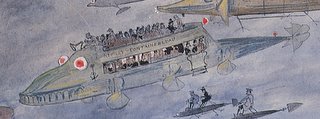
In addition to his science-fiction body of work, Robida issued quite a few travel books and also did a large number of illustrations for contemporary and classic volumes. It was only 20 years ago that Le Vingtième siècle was translated into english and reissued.
- Albert Robida : Visionnaire de la Société du Futur has by far the best quality examples of Robida illustrations - bonus points if you read french. (the .pdf of La Guerre au XXe siècle is complete and excellent)
- The Gallica website at the Bibliothèque Nationale de France has a number of Robida publications but they are all photocopy quality.
- Robida's prefiguring of television at L'Institut National de l'Audiovisuel - (translation).
- Indiana's DePauw University review of Le Vingtième siècle reissue.
- Caricatures/lithographs.
- Caricatures/Lithographs.
- Les explorateurs des millénaires futurs par Mme Hélène Carrère D’Encausse - (translation)


Evanion Ephemera
In his trembling hands lay priceless treasures
for which I had sought in vain.."
[Harry Houdini]
Conjuror and ventriloquist Henry Evans (aka Evanion) was an avid collector of Victorian ephemera relating particularly to the entertainment industry.
The Evanion catalogue is online at the British Library.
[click the images above for larger versions]





